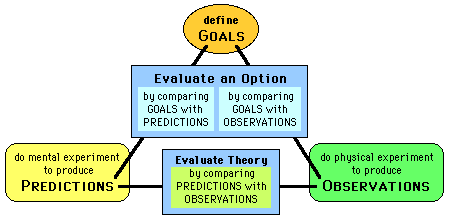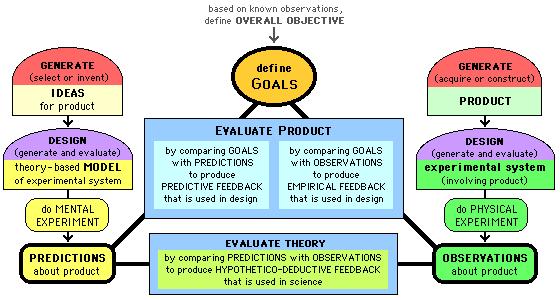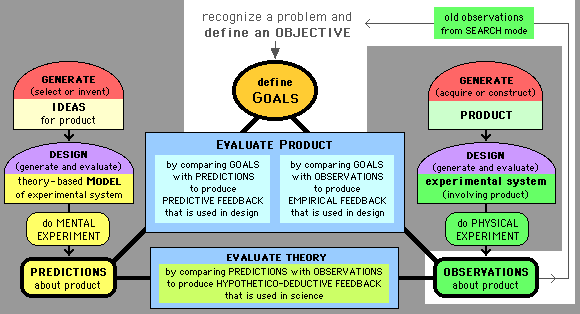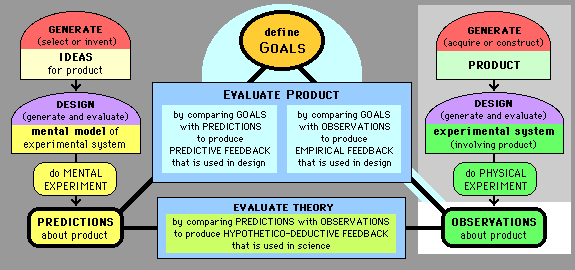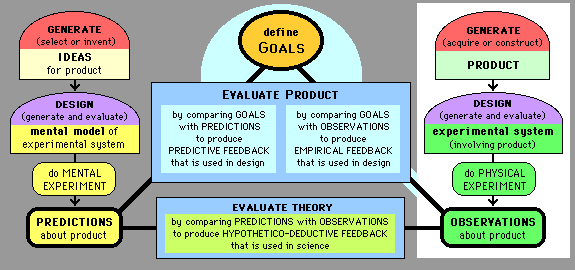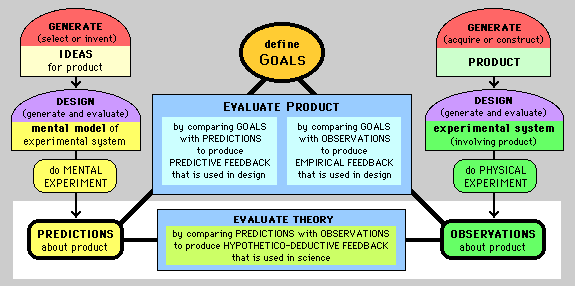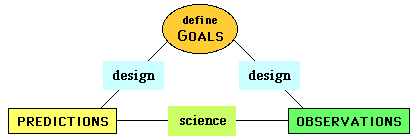1B.
DEFINE GOALS
A variety of goal
criteria -- based on personal values about what is important and
what is good -- are used to judge whether a particular type of goal-state
is desirable.
If the objective is an improved product,
one way to define a goal-state (or a class of goal-states) is to specify
the desired properties for a product in terms of its composition (what it
is), functions (what it does), and performances (how well it performs each
function).
These three general criteria can be split
into sub-criteria that are more specific and concrete. For example,
functions might be defined by asking "Can we make it cheaply?"
and "Will it be durable?" and "Does it appeal to people?"
and "Will they buy it?" The corresponding questions about
performance might be: What level of functioning (for being cheap, durable,
appealing, or sellable) are you hoping for in your most optimistic dreams,
and what level would you accept as minimally satisfactory?
If some criteria are in conflict, how
will you prioritize their relative importance? For example, if increased
durability requires increased cost, how will you balance these conflicting
factors? { But it may not be worthwhile to invest much effort in thinking
about "balancing" until you are evaluating specific competitive
options. At that time, instead of trying to deal with vague generalities,
you may be able to make accurate estimates, such as how much more it will
cost to get a certain level of increased durability. }
Problem solving occurs in three stages:
A) recognizing that a problem exists, that something could be improved
and you have an opportunity to make it better; B) deciding to pursue
a solution for this problem; C) trying to solve the problem,
which occurs when you have achieved an actual state that is a satisfactory
match for the goal state. Stage A is discussed at the beginning of
this section, and Stage C is the main theme of the sections that follow.
Between A and C, however, an important decision must be made in B.
Why? Because even when a problem has been recognized, this does not
guarantee that a solution will be actively pursued. Since there are
many problems, but a limited amount of resources (people, time, money,...)
available for solving problems, decisions about "what to do" are
necessary.
Moving from a problem
to a project (in which you actively pursue
a solution) requires evaluation and decision. You must weigh the potential
benefits of a proposed project, compared with other alternatives, and decide
whether this project is likely to be a wise investment of your time and
effort. In making this decision, it is useful to ask "so what"
questions (Why should we do it? What are the potential benefits? Is it worth
doing?) and practical questions: Is there hope? Are there rational reasons
to expect that our actions will lead to a solution, that this problem can
be solved using available resources such as people and time, materials and
money, technology and knowledge?
2A. SEARCH (gather old information)
During a problem-solving project, an important part
of solving a problem -- of moving from an actual current state to a desired
future state -- is to understand the current state more accurately and completely.
A designer does this by searching for useful information, for observations
about products. This is shown with the white highlighting
below. { note: This "isolation diagram" has been simplified
and streamlined by omitting the initial step, Defining the Objective. } |
|
In addition, there is a semi-white
background (light gray) behind three elements -- generate product, design
experimental system, and do physical experiment -- because when we ask "Are
these actions necessary for remembering?", the answer is YES and NO.
Yes, it is necessary that someone did these actions in the past, to produce
the observations. No, a designer doesn't have to do the experiments,
if the observations (and a description of the products and experiments)
can be found by doing an information search.
Knowing how to find information is a
valuable skill that will become increasingly useful in the future due to
the widespread use of modern information technologies. Learning how
to improve this skill -- how to effectively use libraries, the internet,
databases, and other sources -- will be a good investment of time.
Here are a few suggestions: be persistent (because a thorough search takes
time, and diligence usually is rewarded), knowledgeable (about the "standard
sources" for finding particular types of information), creative (to
find non-standard sources), and critical (to evaluate the reliability of
sources). Be sociable and ask for help from those who know about a
particular field, or from reference librarians who can help you find sources
and develop strategies for searching. Often, libraries offer workshops
showing you how to find information, and internet search services have "tips
for effective searching." {Eventually I'll provide links to
web-pages that discuss strategies for searching. }
In the "isolation diagram"
above, the aqua-colored highlighting shows that searching generates empirical feedback when you compare old
observations (from old experiments on an old product) with
the desired goals for a product.
This feedback -- when it is used as the basis for questions about action
planning, either long-term or simply "what to do next" -- can
stimulate and guide your search. You can ask: Has my search
been thorough, in breadth and depth? Does it have enough breadth?
( Have I checked a wide variety of old products whose compositions
and functions are similar, in one or more ways, to my goal product?
Should I continue searching for more old products? ) Is there
enough depth? ( Do I have enough data about compositions, and
about the performances of each old product for each function? Should
I continue to search for additional data? of what types? )
While you are reviewing what already
is known, you may find an old product (perhaps one that previously was unknown
to you) that satisfactorily achieves your goals, and you consider the problem
to be solved. If not, you can move into an "imagining" mode
of action.
a comment about colorizing: In these
descriptions of IDM, each element of the IDM diagram is highlighted in
bold red print. Each important concept
that isn't in the diagram is in non-bold red print.
2B. IMAGINE (generate and evaluate ideas)
To design,
you must generate and evaluate.
You can generate
ideas for a product in two ways: by selecting an old product (i.e., a product that already exists,
that you have found by searching) or by inventing a new product: |
|
Think about possibilities for
creating new products. How? Since a "new idea" is
usually a variation of an old idea, invention by revision
usually occurs by modifying an old product to generate a new product.
After imagining a new product you can
ask "What properties would it have?" To begin exploring
this question, a common strategy is to make predictions by asking "What
would happen if we used the new product in old experiments?"
Based on knowledge from the SEARCH mode, select an experiment that has been
done with old products. Then run this experiment mentally with the
new product, using "if..., then..." logic:
if the modified product was in this experimental situation, then
we would observe ___ . To fill in the blank with a prediction, do a mental experiment: construct a detailed
mental model of
the experimental system (of the product in its experimental context)
and -- by using everything you know about patterns
and principles (that are based on your knowledge of precedents,
on what you know has happened with old products in this experiment or in
similar experiments) and all you know about the new product -- ask "What
will happen?" to produce predictions about
the product. { As explained in An
Overview of Scientific Method, predictions involve some combination
of theory-based deductive logic and experience-based inductive logic. }
Now you can evaluate
the product by comparing goals with predictions to produce predictive feedback when you ask, "How
well does this new product match my goals for the product?"
Predictive feedback can stimulate several types of action. You may
decide that the new product is a satisfactory solution to the problem.
Or you may want to continue your search by doing goal-oriented invention
of products, design of experiments, or testing of products. These
three actions require creative-and-critical thinking, as described in the
next three subsections.
Goal-Oriented
Invention of Products
The objective of goal-directed
invention is to generate ideas for a product whose properties will
match the desired goal-properties. Whether
or not an existing idea seems satisfactory, you can ask, "Could we
obtain a better product by continuing the process of inventing?"
A simple strategy is to invent LOTS of
ideas, perhaps in a two-phase "brainstorm and edit" process.
Initially, in the creative brainstorming phase, you minimize critical restraints
to encourage a free flow of creative ideas. In the editing phase these
ideas are critically checked for quality and utility. During the creative
phase you can think freely, knowing that any impractical ideas can be modified
(or discarded) during the critical phase. Creativity and criticality
both operate, but not always at the same time.
Typically, the process of invention occurs
in cycles of creative revision, with each successive modification being
guided by critical thinking that is based on scientific principles and on
what has been learned from the predictive feedback in previous cycles.
The main strategy for goal-oriented invention
is the logical process of retroduction.
In contrast with logical deduction that asks, "If this is a true theory,
then what will the observations be?", retroduction -- which uses deduction
and induction supplemented by imaginative creativity -- asks a reversed
question in the past tense, "These were the observations, so what could
the true theory be?" The essence of retroductive inference is
doing thought-experiments, over and over, each time "trying out"
a different theory that is being proposed (by selection or invention) with
the goal of producing predictions that match the known observations.
Basically, the goal is to find a theory that, if true, would explain what
has been observed. This is retroduction in science. In design,
retroduction is similar, except that instead of aiming for predictions that
match observations (as in science, where the
objective is to design a theory), you aim for
predictions that match your goals for the desired
characteristics of a product or strategy.
{ For a deeper discussion of retroductive logic, check the Detailed Examination of Scientific Method. }
A useful sub-strategy is analysis.
While you're in a SEARCHING mode of action, reviewing the properties of
old products, think about the different parts of each product's composition,
and how changes in these parts affect the product's functions
and performances. Search for cause-effect
relationships by asking, "How do changes in what
it is affect what it does and how well it does?" While you're analyzing
a variety of products, comparing their compositions and functions and functional
performances, thinking about similarities and differences, you can search
for correlational patterns and scientific principles. The motivation for theorizing
can be simply to construct new knowledge, or also to construct knowledge
that will help you invent a new product.
Stimulated and guided by these ideas,
you can systematically modify an old product in ways that will generate
a new product with the properties you want. Or combine parts from
several old products. Or look for ideas in other areas; look
at old products, parts, or principles that originally were intended to achieve
goals different than your own goals, and think creatively about how you
can adapt a product that has been "imported from another area"
to help you achieve your goals.
Goal-Oriented Design of Mental
Experiments
The objective of goal-oriented
invention of products is to achieve the main goal of obtaining a
product that satisfactorily matches your goals. By contrast, the purpose
of goal-oriented invention of experiments is
to achieve a sub-goal, to obtain information that will help you achieve
the main goal.
In IDM the definition of "experiment"
is intentionally broad, to cover a wide range of situations: a
physical experiment is loosely defined as "an opportunity
to gather information" whether this occurs in a lab or in the field,
whether there is an attempt to control all known variables or to observe
a product "as it is" in an uncontrolled real-world setting.
There are many possibilities. You might want to focus on getting information
about only one property -- such as a car's acceleration, gas mileage, consumer
appeal, paint durability, or crash safety -- or on testing one component
of a multi-component product. Or you could do an approximation
experiment that has some characteristics (but not all) of an experiment
that would be more realistic but less practical. For example, an experiment
might be run with a smaller scale-model of a large product, or a medical
test might be done with lab animals instead of humans.
Sometimes a visual organization of
information is useful. For example, the grid below can summarize information
(in the 20 yellow-green cells) about five products (in the top row) and
four experiments (in the left column):
| |
Product A
(old) |
Product B
(old) |
Product C
(old) |
Product D
(new) |
Product E
(new) |
Experiment 1 (old) |
|
|
|
|
|
Experiment 2 (old) |
|
|
|
|
|
Experiment 3 (new) |
|
|
|
|
|
Experiment 4 (new) |
|
|
|
|
|
Scanning horizontally across a row
shows the information that is generated, in one type of experiment, about
five different products. Or you can scan vertically down a column,
to see how the properties of one product are revealed in different experimental
contexts.
This grid shows products that are both
old and new, and experiments that are old and new. Each cell can contain
observations (if an experiment has been done already) or predictions, or
both.
For some products it is useful to make
several grids, one for each design decision. For a car, decisions
would include the type of body, trunk, seats, doors, colors, engine, and
transmission. One grid could show possibilities for car bodies (with
different shapes, sizes, materials,...) and experiments (ways to test each
body for aerodynamic efficiency, consumer appeal, manufacturing cost,...)
along with predictions and/or observations. Other grids could show
information about trunks, seats,...
A grid is a useful way to summarize,
in a clearly organized way, knowledge about products and experiments.
By scanning horizontally or vertically, you can focus your attention on
a particular experiment or product. By thinking critically and creatively
about what you see in one scan -- or in several (horizontal, vertical, or
mixed) -- you can search for patterns and principles, and for ways to improve
a product. Or you may notice a knowledge gap when you ask, "Do
the experiments provide satisfactory information about all important properties
of every product, or is there something else that we want to know but don't
know?", and this will inspire the design of new experiments to generate
the desired knowledge.
Goal-Oriented Testing of Products
But information generated in the
mind (by prediction) is usually less reliable than information generated
in the real world (by observation). Therefore, it is often useful
to "do a reality check" by converting
a mental experiment into a physical experiment, to find out whether the
"knowledge" being constructed in your mind is accurate and true,
whether it corresponds to reality.
action decisions: Each cell in
a product-and-experiment grid can be filled with predictions or observations,
or neither, or both. For each cell, for each combination of product
and experiment, you can decide what is the best use of your time:
Should you invest the time that is needed to make a quick-and-rough prediction?
to make a careful prediction? to use a computer simulation for making
a careful prediction? to collect observations by running a simple
small-scale experiment, or an elaborate large-scale experiment?
One important function of mental experiments
is to let you explore, quickly and cheaply, a wide variety of experimental
possibilities. One goal of this exploration is to search for tests
that seem capable of providing useful information, that may be worth doing
as physical experiments in a TESTING mode of action.
2C. TEST (gather new information)
The modes of TESTING (to produce new experimental information)
and SEARCHING (to gather old information that was produced in the past)
are similar. But they always differ in timing, in whether observations
are made in the past or present. Another important difference is that
in SEARCHING you can often take advantage of the experimental work done
by others. Here is the TESTING mode: |
|
For each option
(for each potential product, whether
it is old or new, existing in the mind or in reality), designers use all
available information (from all experiments, old and new, mental and physical)
to evaluate this product by
comparing goals with predictions (to produce predictive feedback)
and comparing goals with observations (to produce empirical feedback)
for the purpose of assigning an intrinsic status
that is an estimate of the extent to which this option achieves the desired
goals. Usually there is a competition between different options, so
a relative status (an estimate for the quality
of a particular option with respect to other options) is also assigned.
Based on their estimates of status, designers
can make several types of decisions.
solution: They may decide
that one option (or combination of options) is sufficiently satisfactory,
so they consider the problem to be solved. { But a "solution"
decision often leads to a new phase of problem solving related to the old
problem, such as deciding how to acquire or produce the product(s), or how
to market, distribute, and sell. }
continue: Or they may try
to develop a product that is even more satisfactory, with continuing action
in the SEARCH, IMAGINE, and TEST modes. Perhaps the evaluation process
has narrowed the focus of "research and development" to revising
a few key aspects of a few products that seem especially promising.
Or there may be an effort to search for new options, or to generate more
information about known options.
abandon: Maybe things are
not going well and they abandon the search for a solution because progress
has been slow, or because despite satisfactory progress they decide that
working on another project is likely to be more productive.
delay: Or they can abandon
the process of R & D temporarily, intending to return later, so they
can work on other projects for awhile. Or perhaps a delay will be
productive without an investment of their own time and effort. This
could occur, for example, if at a later time they will be able to use information
or supplementary technology that in the future will be available due to
the work of others.
settle: Sometimes, however,
an immediate decision is required even though none of the available options
is totally satisfactory, so they "settle for less" and choose
the best available option, if this is better than a delay. Or perhaps,
even if an immediate decision isn't absolutely necessary, a delay would
cause significant disadvantages. { When it seems wise to make a quick
decision, even though evaluation indicates that only a conclusion of "inconclusive"
is warranted, maybe they can make the decision in a way that takes into
account the uncertainties. }
re-aim: Based on what they
have learned during the process of R & D, they may decide to modify
the goal-state. Maybe their original goals now seem impractical and
too difficult to achieve, so the standards for a satisfactory product are
lowered and they are willing to settle for less. Or the standards
can be raised (or changed) if they have recognized or invented new possibilities
for a product with characteristics that are better (or just different) than
what they initially could imagine. Or perhaps, based on revised estimates
of relative importance, there is a change in the "weighting emphasis"
for different types of evaluation criteria, which leads to revised strategies
for achieving an optimal balance between conflicting criteria.
diversify: But designers
aren't limited to only revising old goals. They can also define new
goals that lead to new "spinoff" projects.
As discussed above, many results of evaluation
involve not just the product, but also decisions about action, about "what
to do next." This important aspect of design is discussed later,
in The Generation and Evaluation of Actions.
4. THEORIZE
In a step that is optional
-- that is not necessary when developing a product, but is often helpful
-- a designer evaluates a theory by comparing predictions with observations to produce
hypothetico-deductive feedback. This reality
check is the key step in theory evaluation, in deciding whether "the
way things are according to a theory (and its predictions)" match "the
way things really are (as indicated by observations)." |
|
The Design of Strategies:
As described at the beginning of the "Introduction to Design"
page, strategies can be designed for a wide variety of situations, ranging
from business to basketball, from romance to public policy. Although
in all of the previous descriptions of IDM the focus has been restricted
to products in order to increase the clarity and to minimize the need for
awkward phrases like "product and/or strategy," most of the action
that occurs when designing products also applies to the design of strategies.
Just replace each reference to "product" with "strategy"
and you'll see that the design process is very similar for products and
strategies. But there are some differences, such as a shift, when
predicting or observing, from characteristics (of products) to consequences
(of strategies). This section will examine the differences and the
similarities between a process of design for products and for strategies.
Generating and Evaluating Actions:
A strategy can be the overall objective of design, as in the previous section.
But strategy planning also occurs within the process of design when -- guided
by feedback that enhances their awareness of differences between the current
state and goal state, and perhaps constrained by the limitations of deadlines
and budgets -- designers generate, evaluate, and execute actions that will
help them make progress toward solving their problem. Strategies for
action begin during problem formulation. Later, during the process
of design, these preliminary plans can be modified by improvised planning.
Modes of Action: This will
expand the earlier discussion about interactions between modes (with problem
recognition requiring action in the modes of searching, imagining, evaluating,
and defining goals) and will extend it to other interactions.
Actions and Methods: This
section, which is especially important for education, will explore the relationships
between methods for problem solving (such as those summarized in
IDM) and the thinking actions (such as various applications of creative
and critical thinking) that are used in problem solving. We'll look
at some actions, plus different perspectives on the relationships between
methods and actions.
Enriching IDM: IDM can
be supplemented with ideas from ISM -- such as cultural-personal factors,
thought styles, conceptual factors, and more -- to produce an enriched model
of IDM. Even though IDM is simpler than ISM, design is not simpler
than science, so enrichment is appropriate and useful.
Also, there will be minor revisions
in Section 3 -- mainly by adding an "evaluation analysis" grid
that has options on one axis, criteria [weighted for importance] on another
axis, and evaluations in the cells) -- and Section 4 (with miscellaneous
comments), and in a few other places.
|
|
